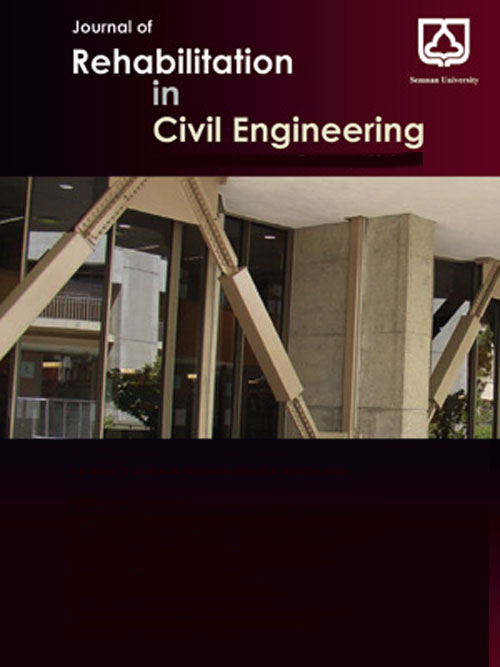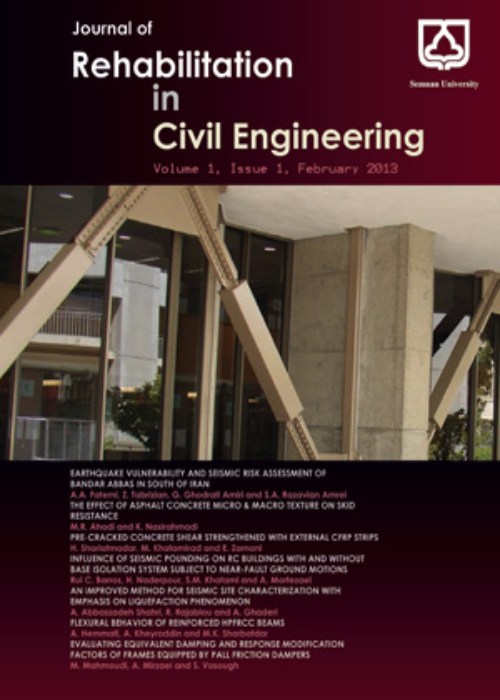فهرست مطالب

Journal of Rehabilitation in Civil Engineering
Volume:2 Issue: 2, Summer - Autumn 2014
- تاریخ انتشار: 1393/08/10
- تعداد عناوین: 7
-
-
Pages 1-10According to Iranian code of practice for seismic resistant design of buildings standard No. 2800, Yazd is located in the place with the medium earthquake hazard [1]. Due to the position of Yazd with many historical and important buildings, maintaining these traditional heritages is an important task in civil engineering field. On account of these mentioned valuable buildings and region potential in constructing the new vital structures, exact regional seismicity surveying and seismic hazard assessment would need to be scrutinized. For this purpose a collected catalogue, containing both historical and instrumental events is used covering the period from the 4th century BC to 2010. Seismic sources are modeled and recurrence relationship is obtained. The method proposed by Kijko [2] and Tavakoli [3] were employed for determination of seismicity parameters. Then logic tree method and weighted attenuation relationships were applied. Probabilistic seismic hazard assessment is carried out using SEISRISK III for Yazd University site. At the end, Peak Ground Accelerations (PGA) of the studied area for a return period of 475 and 2475 years for 10% and 2% probability of exceedance in life cycle of 50 years are evaluated equal to 0.25g and 0.35g.
-
Page 9This paper presents the results of an experimental investigation on shear strength enhancement of reinforced concrete deep beams externally reinforced with fiber reinforced polymer (FRP) composites. A total of six deep beam specimens of two different classes, as-built (unstrengthened) and retrofitted were tested in the experimental evaluation program. Two composite systems namely carbon/epoxy laminates and carbon/epoxy sheets were used for retrofit evaluation. A comparative study of the experimental results with published analytical models, including the ACI 440 model, was also conducted in order to evaluate the different analytical models and identify the influencing factors on the shear behavior of FRP strengthened reinforced concrete deep beams. Experimental results indicated that the composite systems provided substantial increase in ultimate strength of strengthened beams as compared to the as-built beam specimen. The strength gain caused by the CFRP sheets was in the range of 30–58% Analytical Comparison indicated that the shear span-to-depth ratio (a/d) is an important factor that actively controls the shear failure mode of beam and consequently influences on the shear strength enhancement.
-
Page 20The present study assesses the seismic performance of steel moment resisting frames (SMFs) retrofitted with different bracing systems. Two structural configurations were utilized: ordinary concentrically braces (OCBFs), buckling-restrained braces (BRBFs). A 7-story and 18-story steel perimeter SMFs were designed with insufficient lateral stiffness to satisfy code drift limitations in high seismic hazard zone. The frames were then retrofitted with OCBFs with 30, 60, 90, 120 slenderness ratios and BRBFs. Inelastic time-history analyses have been carried out using OPENSEES software for strain hardening from 1 to 10 percent to assess the structural performance under earthquake ground motions. Inter story drifts were employed to compare the inelastic response of the retrofitted frames. It is shown that the distribution of maximum story drifts in the height of BRBFs is more uniform than OCBFs with various slenderness ratios and with increasing strain hardening, the inter story drift and P-∆ effects is decreased. In addition, normal buckling braces with low slenderness ratio behave similar to the BRBFs to control inter story drift, but the cycling behavior in dissipation the energy can’t be changed, and finally the suitable performance from BRBF can’t be obtained.
-
Page 32Scour around hydraulic structures is an inevitable phenomenon. Recognition of this phenomenon and dealing with it is an issue considering which will ensure the project success. Local scour at piers has been reported as the most important factor in the destruction of the bridges. The use of submerged and non-submerged piles is one of the scour control methods. Submerged piles have been rarely used to assess scour. In the present study, the results of some tests with different flow rates and submergence percentages are given in the bridge abutment. The tests have been conducted at clear water conditions in a flume with length of 14m, width of 60cm and depth of 60cm. The results show that the increase in the submergence percentage of piles has a significant role in reducing pier scour.
-
Page 40The present article seek to investigate the function of elliptical steel damper function in steel frames seismic resisting. The elliptical damper is a kind of earthquake energy dissipater in structure which acts based on the steel yielding feature. Thus, this damper in frame lateral displacement mechanism is expected to have a satisfying hysteretic behavior in terms of energy absorption is on acceptable level. To study the EADAS (elliptical added damping and stiffness) elliptical damper function Abaqus software was used in seismic resisting of steel frames. To do the analysis one span- one floor which was modeled with eight kinds of suggested damper was used. The basis of the analysis method is based on the finite element method and a cyclic loading curve was used and the frame will be pushed to the failure of the dampers. The results of the present study indicates that through the addition of this damper with the damage focus in damper the structure elements remain in elastic zone and without any damage bear the lateral load. The damper causes an increase in ductility and the frame energy absorption hysteretic and it can be used for seismic resisting of steel frames.
-
Page 46Endurance time (ET) method is a relatively new performance-based earthquake method for structural evaluation and design. In this method, the structure is subjected to a gradually intensifying accelorogram(s) and its performance is assessed based on the maximum time duration that it can meet the specified performance objectives. Using moment-resisting and braced frames which are rehabilitated by base isolators; it is shown that ET can estimate results of the Incremental dynamic analysis (IDA) with acceptable accuracy. Spectral acceleration has been considered as the intensity measure. While the IDA would require several nonlinear dynamic analyses under multiple suitably scaled ground motion records, the ET can practically estimate the seismic behavior of simple to complex systems only by few nonlinear time history analyses. Moreover, it is shown that even in intense ground motions, super structures do not show considerable nonlinear behaviors and interstory drifts, because of energy dissipating by base isolation. The results also show that the ET method has the benefits of both time history analysis and the simplicity of the nonlinear static methods and can potentially be a useful tool for evaluation and designing seismic-resistant structures.
-
Page 63In the recent years, there have been many new skyscrapers built which soar into new heights. The most efficient building system for high-rises has been the framed tube system. However, the framed tube buildings suffer from shear lag effect which causes a nonlinear distribution of axial stresses along the face of the building. In the present study, the effect of core on shear lag phenomenon in tubular structures is investigated. Three different tubular structure models including model without core, model with central core and model with central core but eliminated in last 15 stories have been analyzed. A shear lag index is defined for evaluating these models. From examination of the results, the effective influence of core for improving the behavior of framed-tube structures has been concluded. The influence of core in reduction of shear lag in first story is estimated by 5%. Investigating the shear lag phenomenon of columns on web frame, it could be revealed that in top story the positive and negative shear lag phenomena have been occurred simultaneously.


